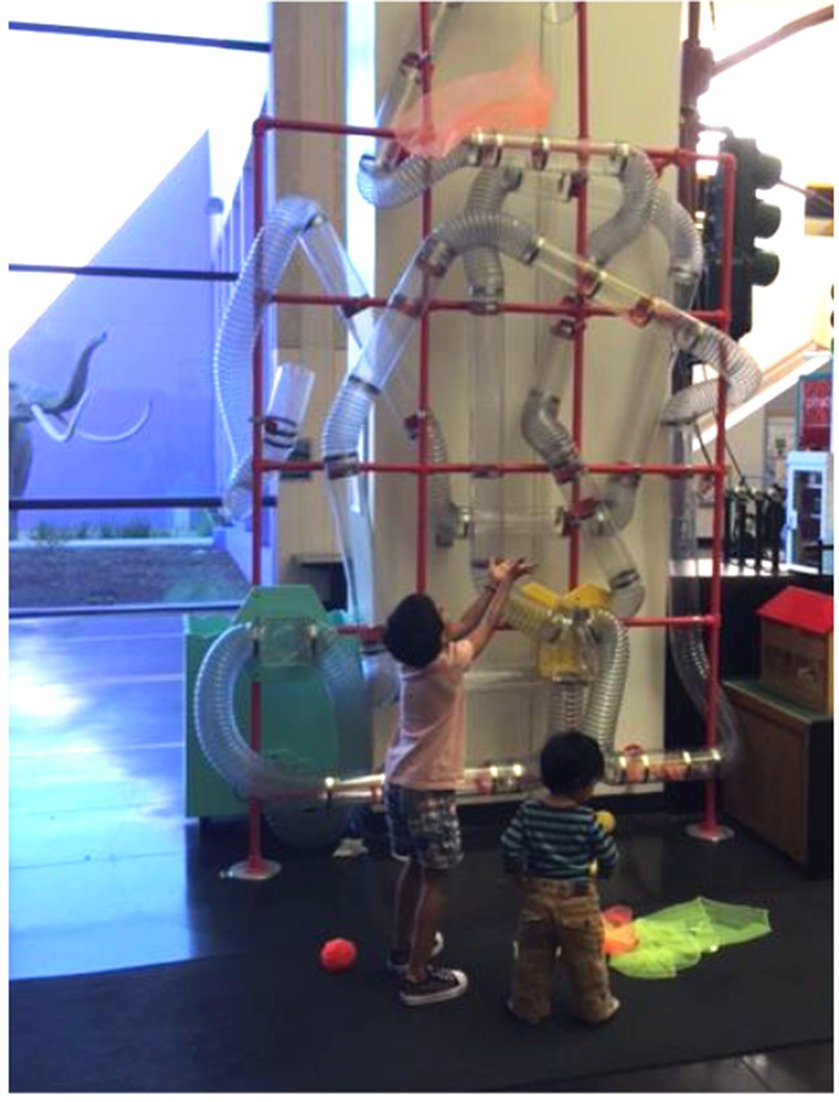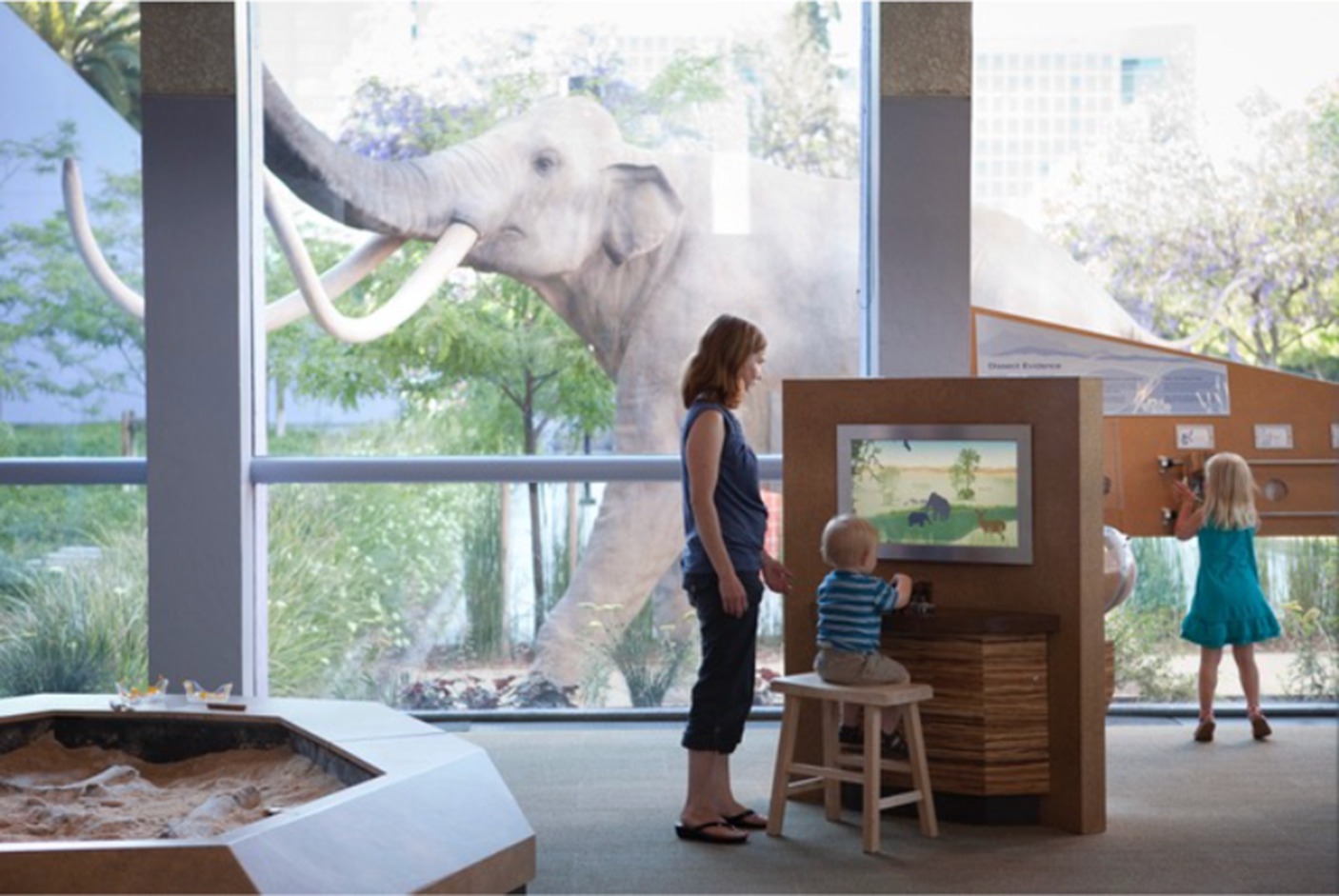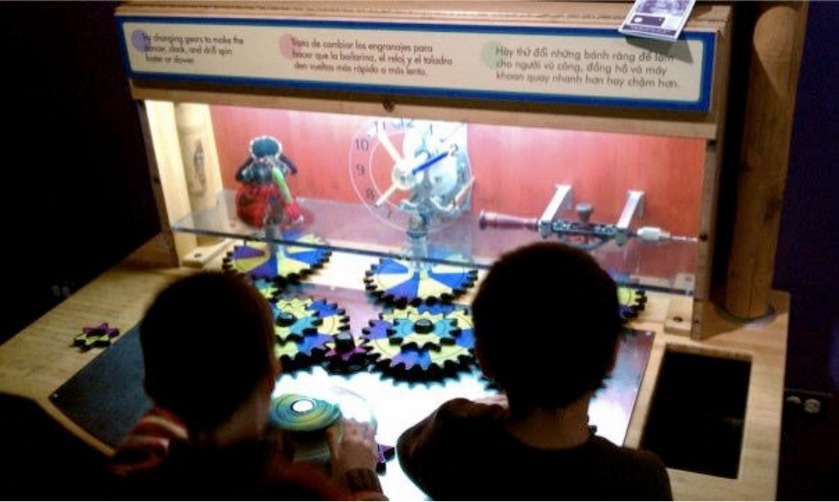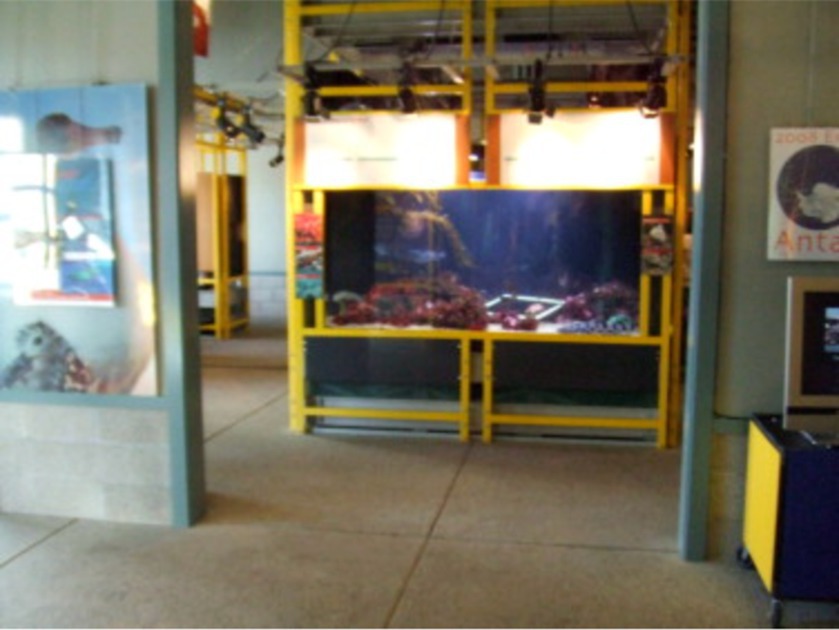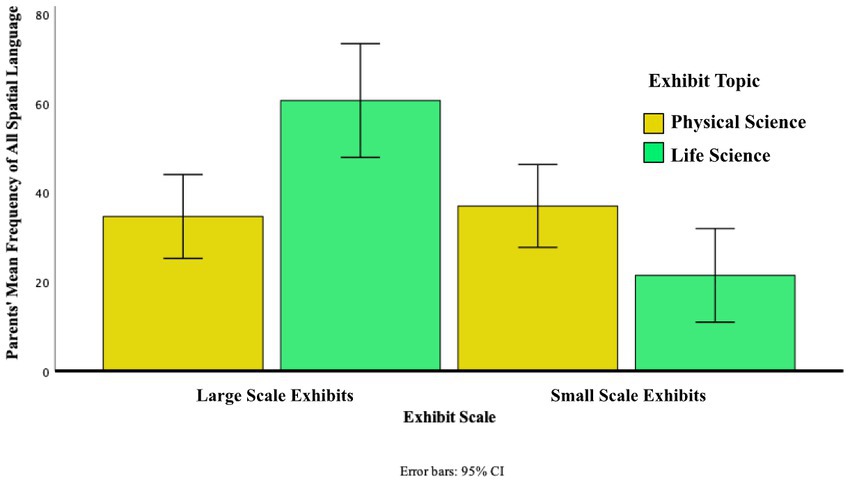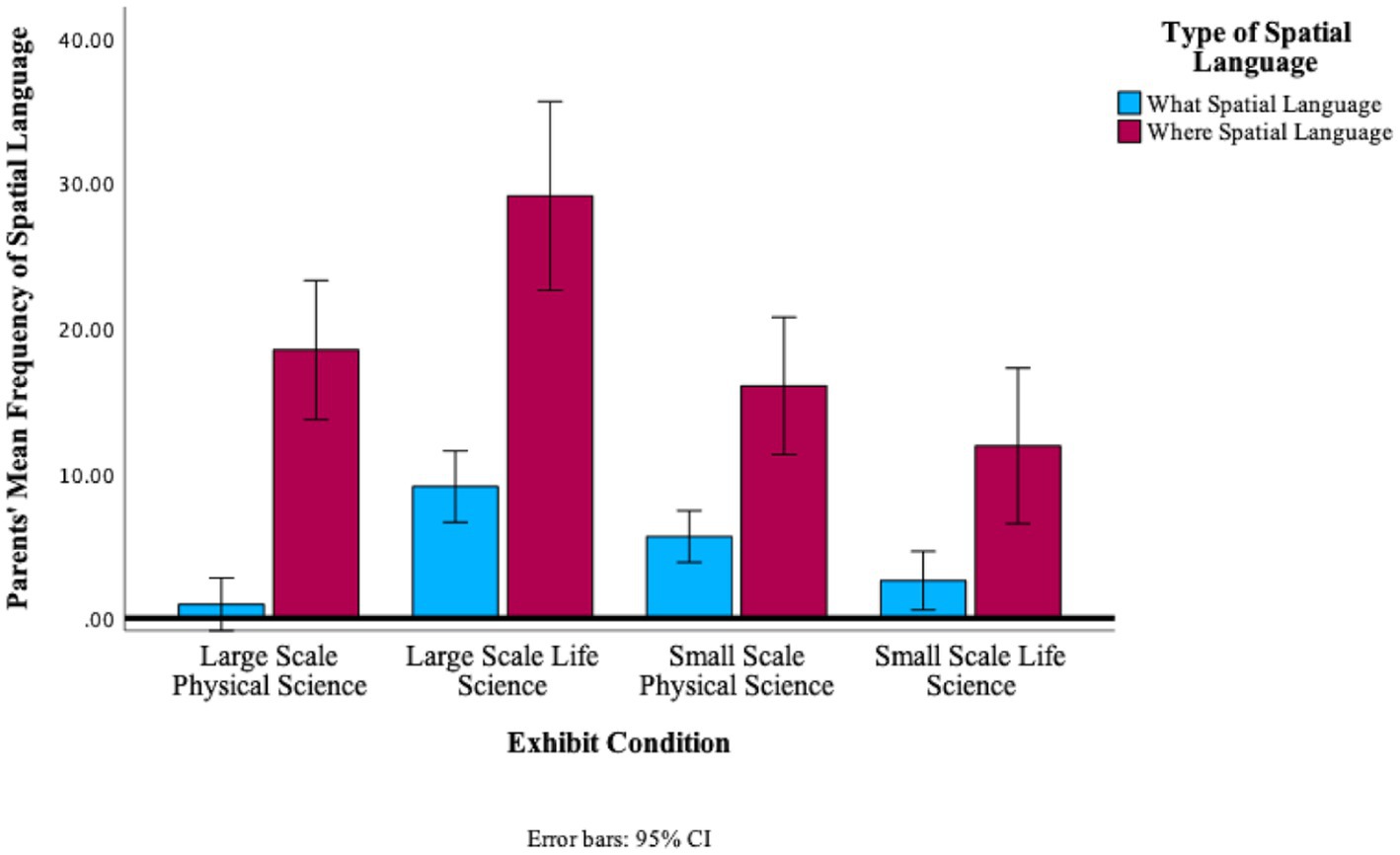- Department of Psychology, University of California, Santa Cruz, Santa Cruz, CA, United States
Introduction: Children are exposed to STEM ideas, including spatial and other mathematical concepts, in a variety of everyday contexts through interactions with their parents. There may be variations in the spatial language that boys and girls hear from their parents within different informal contexts. The present study investigated variations in the frequency and type of parental spatial talk that occurred in museum settings that varied by topic (physical science vs. life science) and exhibit scale (small-scale activity vs. large-scale activity).
Method: The sample consisted of 194 families with children between the ages of 3–6 years who visited museums in Northern California. Of the total sample, 50 families visited a large-scale physical science exhibit, 44 families visited a large-scale life science exhibit, 50 families visited a small-scale physical science exhibit, and 50 families visited a small-scale life science exhibit. Parent–child conversations that occurred during the duration of the museum visit were coded for parents’ spatial language.
Results and discussion: Analyses revealed that parents in the large-scale life science exhibit used more spatial language than parents in the other exhibits. Additionally, parents used more “where” spatial language (spatial language that describes location and directionality) than “what” spatial language (spatial language that describes the look of something) across the exhibit contexts, but especially in the large-scale exhibits. Finally, boys heard more “where” spatial language than did girls across exhibit contexts, whereas there was no difference by gender for “what” spatial language exposure. Variations in the kinds of spatial language that parents use in different environments should be taken into account in developmental models of children’s spatial understanding. Future research is needed to more systematically explore how parents’ spatial language varies across children’s gender, exhibit topic, and exhibit scale.
Introduction
Exposure to spatial concepts in early childhood may have important implications for later learning and achievement in science, technology, engineering, and mathematics (STEM). Particularly when engaging with STEM-related content, talk about spatial concepts may support children’s early understanding of these domains. Hands-on museums provide a valuable context for investigating parent–child interactions because they are settings where children may learn about a variety of STEM-related topics and engage with diverse activities, and where boys and girls may hear different types of language from their parents. Previous research found that boys heard different patterns of spatial talk than girls in home settings (Pruden and Levine, 2017; Ralph et al., 2020), however less research has considered parents’ spatial language while engaging with informal STEM-related activities. Further, more clarity is needed regarding the conditions when gender differences might arise. The present study investigated variations in the frequency and type of parental spatial talk that occurred in museum settings varying in topic (physical science vs. life science) as well as exhibit scale (small-scale activity vs. large-scale activity).
Spatial thinking, which may be important for STEM learning, and especially mathematics, includes understanding, mentally visualizing, and physically transforming objects and locations in space (Cannon et al., 2007). Children’s use of spatial language, involving the words that are used to describe these mental images and transformations, has been shown to be related to mathematics reasoning later in life (Pruden et al., 2011). Taking a sociocultural perspective, we argue that it is important to understand how children learn within their everyday routines (Rogoff, 2003; Rogoff et al., 2018). With regard to spatial concepts, researchers have explored children’s exposure to spatial relational concepts in their everyday conversations with parents (Pruden and Levine, 2017). Notably, there are differences in the amount of exposure that boys and girls tend to have to STEM concepts, with boys typically being more frequently exposed to STEM concepts than girls (Crowley et al., 2001b; Tenenbaum and Leaper, 2003; Pruden and Levine, 2017). Some research has also shown gender differences in exposure to STEM concepts depending on the science topic, such as between life versus physical science (Tenenbaum and Leaper, 2003; Shirefley and Leaper, 2021). According to the United States Census, there are more men than women who have jobs in STEM fields in the United States (particularly in math-intensive areas such as the physical sciences; Martinez and Christnacht, 2021). Many possible reasons have been posed for these discrepancies, including issues related to abilities, preferences, and both explicit and implicit bias (Charlesworth and Banaji, 2019). Another possible cause may be inequities in amount and quality of early experiences with STEM concepts (Cheryan et al., 2017). Because of these gender-specific differences in the amount of exposure to STEM concepts in childhood, and topic-specific career differences by gender, it is important to look at children’s early exposure to spatial language within informal learning settings, such as science museums.
This study aims to investigate the early origins of spatial language exposure for boys and girls within a variety of STEM contexts. We consider museum contexts that vary both in topic (life science and physical science) and in scale (small-scale single-location exhibits and large-scale room-sized exhibits). As background, we first review existing literature on the relation between parents’ spatial talk and children’s spatial skill development. Next, we look at the existing literature on average gender differences in exposure to spatial and broader STEM concepts within everyday family conversations. Then, we examine research looking at family interactions with science concepts in a variety of museum settings. Finally, we introduce the current study.
Parents’ spatial talk and children’s spatial skill development
Spatial skills in academic settings as early as preschool have been found to be associated with later mathematics skills (Gunderson et al., 2012; Verdine et al., 2014; Pruden and Levine, 2017). Spatial skills can be encouraged through parents’ support. For example, maternal support of spatial skills in three-year-olds in observational studies has been shown to be predictive of mathematics skills at 4½ years old (Lombardi et al., 2017). In two studies with 4-year-olds, researchers found that children’s exposure to spatial language was correlated with their own spatial language usage and spatial skills (Polinsky et al., 2017; Casasola et al., 2020).
Spatial language categories have been theoretically separated into spatial words that describe the “what” versus “where” of space (Landau and Jackendoff, 1993; Verdine et al., 2016; Pruden and Levine, 2017). “What” spatial categories include descriptive words relating to spatial dimensions, spatial features and properties, and shapes of objects, such as big, small, circle, wide, and size. “Where” spatial categories include words that relate to where objects are located in space such as by, below, across, left, and right. Children’s exposure to parents’ “what” spatial language has been found to be positively correlated with children’s spatial language production, which in turn is correlated with greater performance on a spatial skills task (Pruden and Levine, 2017).
Average gender differences in exposure to spatial language
Researchers have found gender-related inequities in the amount of exposure that boys and girls tend to have to spatial language and other STEM-related talk. In an at-home longitudinal naturalistic observational study of parent–child interactions with a 60% majority white sample, Pruden and Levine (2017) found that boys and girls between 14- to 46-months old heard different types and amounts of spatial language. More specifically, boys were exposed to more “what” spatial language (i.e., shape, dimension, and spatial feature) than girls, which in turn positively correlated with the amount of spatial talk that the boys themselves produced (Pruden and Levine, 2017). There were no gender differences in exposure or production found for “where” spatial language or any other categories of spatial language in this study (Pruden and Levine, 2017). In a different study done with a sample of mostly highly educated, middle and high SES mothers, researchers found that mothers used significantly more spatial language with PreK boys than with PreK girls (Ralph et al., 2020). The spatial language that was measured in this study included “what,” “where,” and orientation and transformation terms. In contrast to their findings with younger children, Ralph et al. (2020) found that mothers of kindergarten and first-grade children used significantly more spatial language with girls than boys. These divergent results point to more research being needed on the situations where gender differences appear in the amount and kinds of spatial language that young boys and girls hear in conversations with parents.
Some research suggests that parents’ gender-differentiated communication in science-related contexts may depend on the science topic. For example, Tenenbaum and Leaper (2003) observed that fathers from a majority white middle-class sample used more science-teaching talk with school-age sons than daughters during an at-home science teaching task—but only during a physical science activity and not during a life science activity. However, Shirefley and Leaper (2021) observed that parents from a majority white sample used more science teaching talk with their young daughters than sons while reading a book on physical science, but not when reading a book on life science. These two studies differed in the children’s ages (early vs. middle childhood) and type of setting (teaching activity vs. book reading). Therefore, it is unclear if and how these differences might apply to the current study’s focus on parents’ spatial language with young children at a science museum. Nonetheless, these studies suggest that parents’ gender-differentiated talk might partly depend on the science topic of the museum exhibit.
Exploring science in different museum environments
Science museums and children’s museums provide important contexts for looking at parent–child interactions because museums are settings that integrate features of formal and informal learning environments. Whereas the signs and other intentional learning tools of museum exhibits can resemble school-like formal learning settings, learning in museums is usually open-ended and voluntary, and varies depending on individuals’ and families’ styles of engagement. Children and their families who visit science museums are able to further explore what is most important to them in a more hands-on way than they might encounter in a formal school setting, both with each other and within the intentional exhibit organization (Crowley et al., 2001a; Rogoff et al., 2016).
The ways in which families interact with science exhibits may vary depending on physical features of the exhibit, including size, scale, accessibility, and interactivity (Afonso and Gilbert, 2007; Wineman and Peponis, 2010). Both large-scale immersive and small-scale tabletop exhibits have been found to be engaging for museum visitors (Dancstep et al., 2015). Past research has found that tabletop exhibits promoted more scientific reasoning about exhibit content while immersive exhibits were reported to be more enjoyable for parents and children (Dancstep et al., 2015). Discrepant findings emerged from studies that measured time spent. In one study, families spent more time at tabletop exhibits than at immersive exhibits (Dancstep et al., 2015), but another study found that families spent significantly more time in larger immersive exhibits as opposed to other exhibit types (Gilbert, 2002). This may be due to the nature of the exhibits, not only in relation to their scale. Parents were found to use more high-level spatial language (talking about how or why spatial relations are as they are) while talking about tabletop exhibits compared with immersive exhibits (Dancstep et al., 2015).
The current study
The current study investigated variations in the frequency and type of parental spatial talk that occurred in museum settings varying in topic (physical science vs. life science) as well as exhibit scale (small-scale activity vs. large-scale activity). As mentioned, prior research has shown differences in the amount of science talk that boys and girls heard within museums (Crowley et al., 2001b), as well as in the types of spatial talk boys and girls heard at home (Pruden and Levine, 2017). Parents’ science talk may vary depending on whether the context is life science or physical science (Tenenbaum and Leaper, 2003; Shirefley and Leaper, 2021), and whether the spatial arrangement is small-scale or large-scale (Dancstep et al., 2015). The field has yet to address whether gender-specific differences in children’s exposure to spatial language would vary depending on topic and scale within a science context. Following the majority of the previous research, we predicted that parents of boys would be more likely than parents of girls to use spatial language overall (Pruden and Levine, 2017), and that parents of boys would use more “what” spatial language (describing shape, dimension, and spatial feature) than parents of girls (Pruden and Levine, 2017). Finally, we explored whether there was variation in the amount and types of spatial language talk that parents used with their children in physical and life science exhibits and in large-scale and small-scale exhibits, tentatively predicting that more “where” spatial talk might occur in larger exhibit environments.
Method
Participants
The samples of participants for this study were taken from existing data sets collected at Children’s Discovery Museum of San Jose (Callanan et al., 2017, 2020; McHugh et al., 2023), as well as from Seymour Marine Discovery Center in Santa Cruz, CA (Rigney and Callanan, 2011). The families included a child between the ages of 3 and 6 years and at least one parent. Of the total sample size of 194 families, 50 families (mean age 64 months, 50% girls) visited a large-scale physical science exhibit at Children’s Discovery Museum of San Jose, CA; 44 families (mean age 64 months; 54% girls) visited a large-scale life science exhibit at Children’s Discovery Museum of San Jose, CA; 50 families (mean age 64 months; 56% girls) visited a small-scale physical science exhibit at Children’s Discovery Museum of San Jose, CA; and 50 families visited a small-scale life science exhibit at Seymour Marine Discovery Center in Santa Cruz, CA. Data collection methods differed for the small-scale life science exhibit, and only age in years was obtained. The mean age of the participants was 4 years and 22 out of the 50 participants were girls (44%).
Demographics information was collected for families at three exhibits (n = 144 families), but not at the small-scale life science exhibit. In an open-ended question, parents were asked to describe their family’s ethnicity. Out of these 144 participants, 44 identified as White or European-American (30.3%), 8 identified as Hispanic or Latinx (5.6%), 54 identified as Asian or Asian-American (38%), 25 identified as mixed race or ethnicity (17.4%) and 13 did not report their race or ethnicity (9%). The parents also reported on their education background, and 13 had a Doctorate degree (9%), 59 had a Masters or other advanced degree (41%), 42 had a Bachelors degree (29.2%), 8 had an Associates degree (5.6%), 10 had some college experience (7%), 7 had a high school degree (5%), 1 had some high school experience (1%), and 4 did not report on their education background (3%).
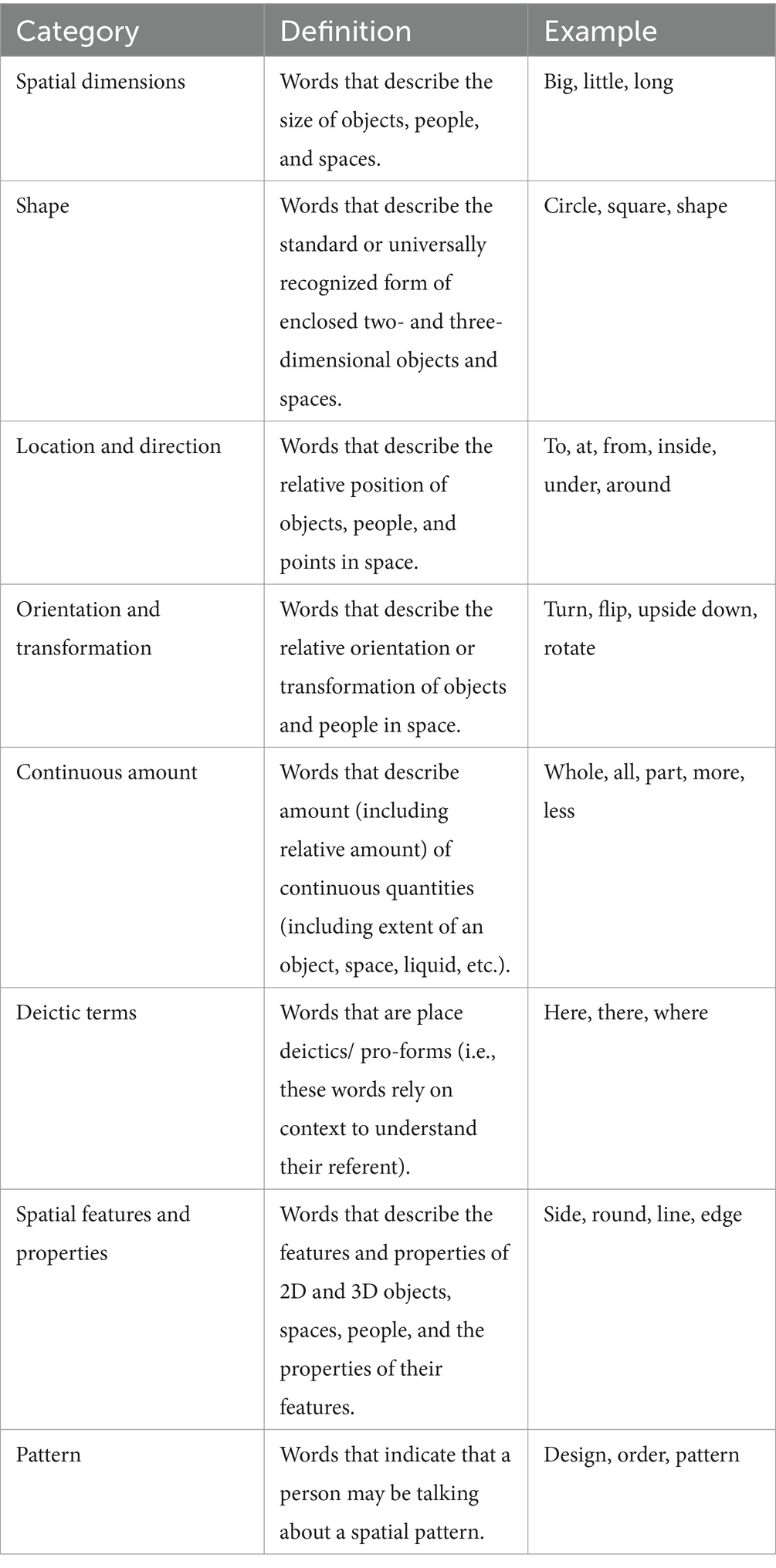
Table 1. Definitions of spatial language categories (Cannon et al., 2007).
Materials and procedure
The data used for these analyses come from four different previous projects in which parents were invited to participate in a study of how children learn in museums (Rigney and Callanan, 2011; Callanan et al., 2017, 2020; McHugh et al., 2023). In each case, parents were invited to participate with their children, the study was explained, and they were asked to sign a consent form. After parents gave written consent and children gave verbal assent, children were asked to wear a sticker showing that they had consent to be video- and audio-recorded while visiting particular exhibits. Parents either wore a lapel microphone or a microphone was embedded in the exhibit. Cameras were set up near the exhibit space with a sign informing families that “Researchers are at work while you are at play,” however the camera was only turned on when a child with a sticker was at the exhibit. For the large-scale physical science exhibit only, the exhibit was blocked off during data collection so that one family at a time interacted with the exhibit. With the other three exhibits, researchers attempted to capture only the participant family on video and any other families inadvertently on camera were not coded or analyzed. In the case of the small-scale life science exhibit, the video recordings were the extent of data collected; in the other three cases, families were also invited to be interviewed and/or engage in other activities either before or after the exhibit visit.
Large-scale physical science exhibit
The large-scale physical science exhibit investigated for this study was “Amazing Airways” (see Figure 1) within Children’s Discovery Museum of San Jose (McHugh et al., 2023). There were 109 families who participated in the large-scale physical science exhibit, and within the sample there were 53 boys and 56 girls. In order to have a comparable number of participants in all of the exhibits, 50 participants were randomly selected for this study from the total of 109 participants, with the constrained that they were approximately matched by age and gender to the participants in the other exhibits.
This exhibit consisted of an interactive air flow tube. The tube had an entry point for small balls. There was also a knob several feet away from the tube that could be manipulated to change the direction of airflow leading the balls to different exit points. Families were instructed by researchers to play with the exhibit in an open-ended way. These interactions were audio- and video-recorded.
Large-scale life science exhibit
The large-scale life science exhibition was “Mammoth Discovery!” (see Figure 2) at Children’s Discovery Museum of San Jose, which is located in San Jose, CA (Callanan et al., 2017). There were a total of 83 families who participated in the original “Mammoth Discovery!” study. The full sample included children outside of the age range for this study; 44 families out of the original sample fit the 3- to 6-year-old age range and were in included in the coding and analysis for this study. The families were video- and audio-recorded during their time in the exhibition. The families were instructed to take as much time as they would like at the exhibit.
The “Mammoth Discovery!” exhibition consisted of several stations including real fossilized bones and bone replicas, as well as several exhibits designed for active engagement. For example, the Femur Chair exhibit included a chair next to a display of the mammoth’s femur bone to encourage comparing it to the child’s own bone, and interactive dig pits allowed children to physically dig for bone replicas using provided tools.
Small-scale physical science exhibit
The small-scale physical science exhibit was the Gears exhibit, developed as part of the larger “Secrets of Circles” exhibition (see Figure 3) at Children’s Discovery Museum of San Jose (Callanan et al., 2020). There were 109 families who participated in the small-scale physical science exhibit, and within the sample there were 51 boys and 58 girls. In order to have a comparable number of participants, 50 participants were randomly selected for this study from the total of 109 participants, with the constraint that they were approximately matched by age and gender to the participants at the other exhibits.
This exhibit consisted of a large magnetic table with gears on it. The gears could be moved around the table. At the back of the table there were three stationary gears with a doll, a clock, and a drill attached to the tops of them. A sign encouraged visitors to move the gears on the table to connect and try to make the doll, clock, and drill move faster or slower. These interactions were audio- and video-recorded.
Small-scale life science exhibit
The small-scale life science exhibition was “Rocky Reef” (see Figure 4) within the Seymour Marine Discovery (Rigney and Callanan, 2011). There were 107 families who participated in the small-scale life science exhibit, and within the sample there were 58 boys and 49 girls. The children in the original study ranged from 1- to 12-years-old, so a sample of 50 participants who fit the 3- to 6-year-old age range criteria for this study were randomly selected from the original sample, with the constraint that they were approximately matched by age and gender to the participants in the other exhibits.
This exhibit consisted of an observational aquarium tank. Within the tank there were living sea creatures, some which moved around the tank (such as fish) and some which were more stationary (such as sea stars). Beside the tank there was a sign describing what kinds of animals and plants live in the exhibit. The interactions at the tank were audio- and video-recorded.
Coding spatial language
For this study, the categories of spatial language are defined by the coding scheme System for Analyzing Children’s Language About Space (Cannon et al., 2007). The museum visits were transcribed and then coded for parents’ spatial language use. The coding scheme, shown in Table 1, outlines eight different spatial language categories: spatial dimensions (e.g., big, little, wide), shapes (e.g., circle, triangle, square), location and directions (e.g., at, underneath, left, right), orientation and transformation (e.g., turn, rotate, upside down), continuous amount (e.g., whole, part, piece), deictic terms (e.g., here, there, anywhere), spatial features or properties (e.g., round, corner, angle), and pattern (e.g., first, next, last; Cannon et al., 2007). Spatial dimension, spatial features and properties, and shape were considered part of the “what” spatial category, and location and direction were identified as the “where” spatial category. Orientation and transformation, continuous amount, deictic terms, and pattern were not counted as either “what” or “where” spatial language.
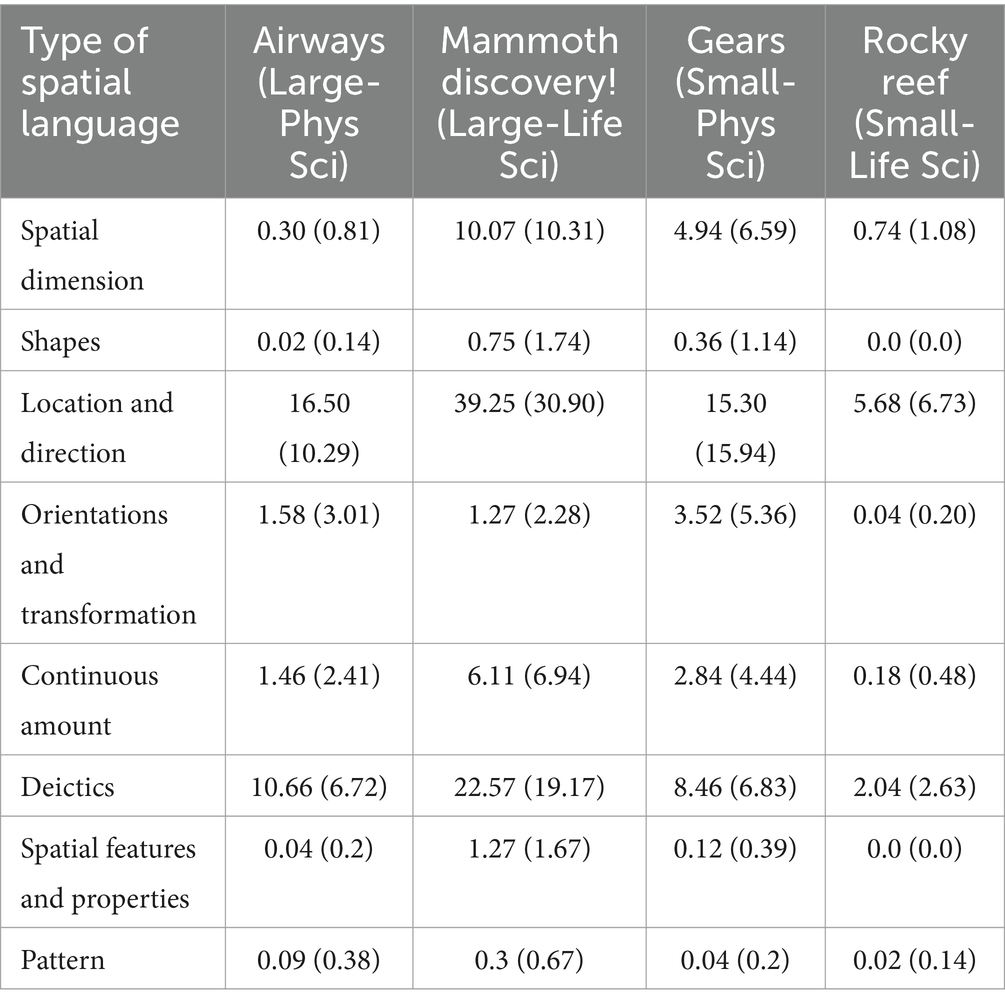
Table 2. Parents’ mean frequency (and standard deviation) for different use of types of spatial talk by exhibit.
We calculated reliability first to identify spatial language used in a spatial way. For example, if a child answered a question and the parent responds with “that’s right!” the word right was judged in this context to be not spatial. In contrast, “look on the right” would be identified as spatial because it refers to direction. Both the video recordings and transcripts were used to code the dataset. Video recordings helped coders to understand how language was used in context, and to determine whether or not a word was used spatially when it was not immediately clear from the transcripts. An example of this would be if a parent said the utterance “there.” Without a pointing gesture, the word would not be coded as spatial, but paired with the parent pointing to something, the word “there” would be coded in the Deictics category.
Three coders obtained reliability on the first step for the “Gears” exhibit, with percent agreement ranging from 81 to 89% and Cohen’s kappas ranging from 0.65 to 0.79. Two coders obtained reliability on the “Mammoth Discovery!” exhibit with percent agreement of 85% and Cohen’s kappa of 0.69. Two coders obtained reliability on the “Rocky Reef” exhibit with percent agreement of 98% and Cohen’s kappa of 0.95. Two coders obtained reliability on the “Amazing Airways” exhibit with percent agreement of 92.5% and Cohen’s kappa of 0.84. All disagreements were resolved through discussion and coders divided the remaining transcripts equally.
Next, we coded each spatial term into one of the categories in Table 1 and calculated reliability on 20% of the transcripts for each sample. Three coders obtained reliability on the second step for the “Gears” exhibit, with percent agreement ranging from 93 to 98% and Cohen’s kappas ranging from 0.90 to 0.97. Two coders obtained reliability on the “Mammoth Discovery!” exhibit with percent agreement of 96.8% and Cohen’s kappa of 0.95. Two coders obtained reliability on the “Rocky Reef” exhibit with percent agreement of 97.3% and Cohen’s kappa of 0.95. Two coders obtained reliability on the “Amazing Airways” exhibit with percent agreement of 99.3% and Cohen’s kappa of 0.99. After obtaining reliability, the coders resolved disagreements through discussion, and then, dividing the remaining transcripts evenly, completed the coding.
Data analysis
Analyses were conducted in order to address whether there was variation in the total amount of spatial language that parents used with their children in large-scale and small-scale physical science exhibits and in large-scale and small-scale life science exhibits. Additionally, we analyzed the data to ask whether parents of boys used more spatial language than parents of girls. Finally, we separately looked at the amount of “what” spatial language (describing shape, dimension, and spatial feature) and “where” spatial language (describing location and direction) to see if there was a difference in exposure to these categories of spatial language by gender, exhibit topic, and exhibit scale. Because families spent different amounts of time at the different exhibits, we chose to control for time spent at the exhibits within our analyses.
Results
Parents varied in their use of spatial language across the different exhibits and the different categories of types of spatial language. The mean frequencies of parents’ use of the different categories of spatial language talk by exhibit are shown in Table 2.
Our first research question asked whether there was variation in the overall amount of spatial language that parents used with sons and daughters in physical and life science exhibits of different scales. We had predicted that boys would be exposed to more spatial talk than girls and had no clear predictions about the kinds of variation in the amount and kinds of spatial talk that parents would use with their children depending on the exhibit topic or exhibit scale. Families on average spent more time in the large-scale life science exhibit (an average of 20.5 min) than in the large-scale physical science exhibit (an average of 7.25 min), the small-scale physical science exhibit (an average of 8.2 min), and the small-scale life science exhibit (an average of 1.9 min), so we controlled for time spent at the exhibit with an analysis of covariance (ANCOVA). We conducted a 2 (Gender) × 2 (Exhibit topic: Life science, Physical science) × 2 (Exhibit scale: Large scale, Small scale) ANCOVA with time in minutes as the covariate. This ANCOVA revealed a significant main effect of Exhibit scale in the amount of total spatial talk that children heard from their parents, as well as a significant interaction between exhibit topic and exhibit scale (Figure 5), F(1, 184) = 13.81, p < 0.001. As shown in Table 3, follow-up paired comparison tests revealed that more total spatial language was used in the large-scale life science exhibit than in any of the other exhibits. There were no significant differences found related to gender. Lastly, there was a significant interaction between time spent in the exhibit and total spatial language, F(1, 193) = 26.53, p < 0.001, reinforcing the importance of controlling for time in the analysis.
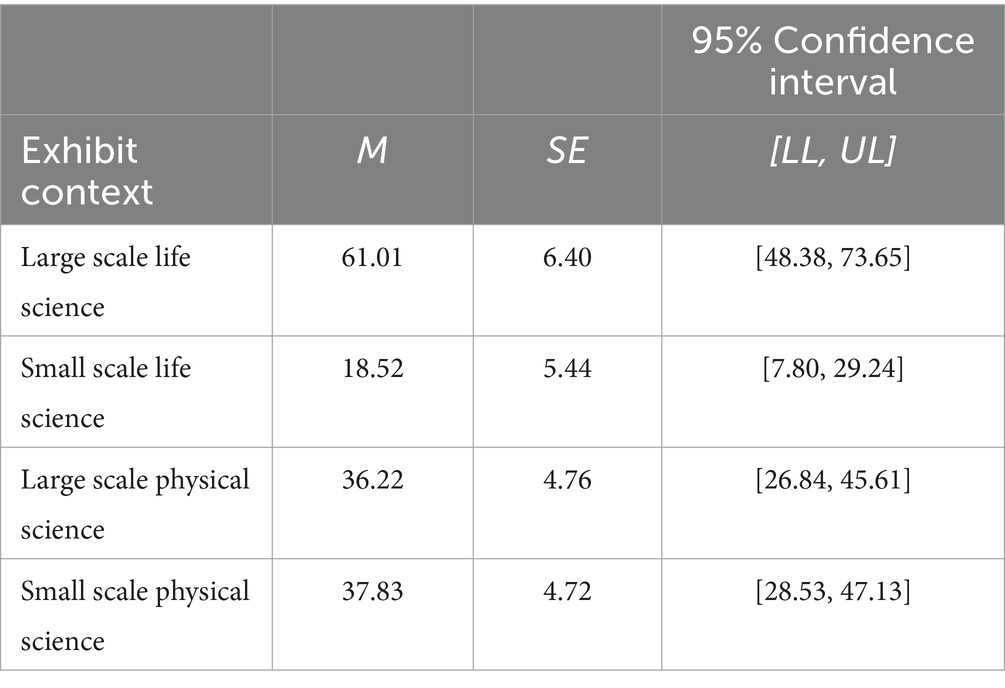
Table 3. Parents’ mean frequency (with standard error and confidence intervals) of overall spatial language by exhibit context.
Our second research question asked more specifically about children’s exposure to the subcategories of “what” and “where” spatial language. Parents’ spatial language was analyzed with a four-way mixed 2 (Gender) × 2 (Exhibit topic) × 2 (Exhibit scale) × 2 (Type of spatial language: What, Where) ANCOVA with gender, exhibit topic, and exhibit scale as between-subject variables and with the type of spatial language as a repeated measure, covarying time spent at exhibit. This analysis yielded several significant results. First, there was a significant main effect of type of spatial language; with “where” spatial language being used more on average than “what” spatial language, F(1, 185) = 23.40, p < 0.001. Next, there was a significant interaction between exhibit scale and type of spatial language (see Figure 6), F(1, 185) = 13.01, p < 0.001. For “where” spatial language, a large effect between the large scale (M = 23.88) and small scale exhibits (M = 13.92) was detected, F(1, 185) = 12.11, p < 0.001, ηp2 = 0.61, with parents using more “where” spatial language in the large-scale than the small-scale exhibits. For “what” spatial language, there was no significant difference based on scale, F(1, 185) = 0.82, p = 0.364, ηp2 = 0.004. Finally, we found a significant interaction between child gender and child exposure to “what/where” spatial language (see Figure 7), F(1, 185) = 8.15, p = 0.005. For “where” spatial language, a large effect between speech to boys (M = 21.50) versus girls (M = 16.29) was detected, F(1, 185) = 4.655, p = 0.032, ηp2 = 0.025. For “what” spatial language, there was no significant difference, F(1, 185) = 0.704, p = 0.402, ηp2 = 0.004.
Discussion
In the present study we explored parents’ spatial talk to young children, exploring variations in frequency and type of parental spatial talk within several museum contexts that varied by science topic and exhibit scale. We found evidence of topic-specific, scale-specific, and gender-specific differences in the amounts and kinds of spatial talk that children heard from their parents in these science museum contexts. Specifically, there was variation in the kinds of spatial talk that boys and girls were exposed to, with boys hearing more “where” spatial language than girls. In contrast, there were no statistically significant gender differences found in children’s exposure to “what” spatial language or to overall spatial language. These results differ from past research that had found gender differences in child exposure to “what” spatial language, but not in other types of spatial language or overall spatial language (Pruden and Levine, 2017). Our finding also differs from research that had found gender differences in overall spatial language exposure for PreK children, with boys being exposed to more spatial language of all types than girls (Ralph et al., 2020). It is unclear why the present study found gender differences in “where” spatial language what.
We found no evidence of gender differences related to science topic (physical vs. life science) or exhibit scale (large or small scale). However, we did find that parents used more “where” spatial talk, focused on location and direction, when they were in the large-scale life science exhibit environment. This makes sense because this particular exhibition had many parts that were related to one another. For example, when interacting with a replica of the mammoth skull, parents may have made comments about the location of the authentic fossilized skull in another part of the room.
Much of the research on parents’ spatial language with children has investigated parents’ talk during everyday activities at home (Pruden and Levine, 2017). What this study adds is a more systematic focus on how spatial talk may vary depending on the specific topics under discussion as well as the particular characteristics of the spatial environment. Our data suggest that the characteristics of the space were more important than the topic. The large-scale life science exhibit stood out as the environment where parents were most likely to use “where” spatial terms. This environment was also the most expansive space we considered, which may account for the finding.
It may be surprising that there were few differences in parents’ spatial talk related to children’s gender. And yet, as the literature review shows, the findings regarding gender and STEM-related talk have been quite mixed (Crowley et al., 2001a,b; Pruden and Levine, 2017; Ralph et al., 2020; Shirefley and Leaper, 2021). Perhaps gender stereotypes have led to an expectation that boys will hear consistently more spatial talk; this expectation has not been widely supported and it may be time for the field to clarify the conditions under which gender differences do and do not appear.
Several limitations of this study could be addressed in future work. First, the four exhibits studied differ in other ways beyond large scale vs. small scale and life science vs. physical science. For example, the large-scale life science exhibit included many different stations with an overarching subject of mammoths, and the large-scale physical science exhibit included one interactive station that spanned a large area of space. Therefore, future research should consider differences in the kinds of interactions that occur at exhibits with different physical structures. Further development of the coding scheme may also be useful since it may not have captured all the spatial language that parents used. For example, the word “spin” was used frequently at the Gears exhibit but this word was not a part of Cannon et al.’s (2007) coding scheme. Future research could expand the existing coding scheme to better encompass the spatial language that is most relevant in the specific context studied.
Although more research is needed on this topic, our findings add to the existing literature on parent–child conversations regarding STEM topics, and more concretely contribute to research that looks at everyday conversations involving spatial talk in science settings. These results also add more information about the kinds of variation in spatial talk that boys and girls hear in conversations with their parents. Further investigating the kinds of exposure that children have to spatial language and concepts outside of school contexts can better inform researchers about how spatial understanding, and other aspects of STEM knowledge, develop through everyday interactions.
Data availability statement
The data analyzed in this study is subject to the following licenses/restrictions: when consent was obtained, participants were told that data would not be shared. The data includes identifiable information about the participants as it is video recording and transcriptions of parent–child conversations. Requests to access these datasets should be directed to VU, dnVtYW5za3lAdWNzYy5lZHU=.
Ethics statement
The studies involving humans were approved by University of California Santa Cruz (UCSC) Institutional Review Board (IRB) and Office of Research Compliance Administration (ORCA). The studies were conducted in accordance with the local legislation and institutional requirements. Written informed consent for participation in this study was provided by the participants’ parents/legal guardians. Written informed consent was obtained from the individual(s), and minor(s)’ parent/legal guardian, for the publication of any potentially identifiable images or data included in this article.
Author contributions
VU: Writing – original draft, Writing – review & editing, Conceptualization, Formal analysis. MC: Writing – original draft, Writing – review & editing, Conceptualization, Funding acquisition, Investigation, Supervision.
Funding
The author(s) declare that financial support was received for the research, authorship, and/or publication of this article. The data used in these analyses were collected as part of several projects funded by the National Science Foundation: Lupe’s Story, DRL-0741583, Collaborative Research: Explaining, Exploring, and Scientific Reasoning in Museum Settings, DRL-1420259, Round and Round, ESI-0229872, and Center for Informal Learning and Schools (CILS), ESI-0119787.
Conflict of interest
The authors declare that the research was conducted in the absence of any commercial or financial relationships that could be construed as a potential conflict of interest.
Publisher’s note
All claims expressed in this article are solely those of the authors and do not necessarily represent those of their affiliated organizations, or those of the publisher, the editors and the reviewers. Any product that may be evaluated in this article, or claim that may be made by its manufacturer, is not guaranteed or endorsed by the publisher.
References
Afonso, A. S., and Gilbert, J. K. (2007). Educational value of different types of exhibits in an interactive science and technology center. Sci. Educ. 91, 967–987. doi: 10.1002/sce.20220
Callanan, M. A., Castañeda, C. L., Luce, M. R., and Martin, J. L. (2017). Family science talk in museums: predicting children's engagement from variations in talk and activity. Child Dev. 88, 1492–1504. doi: 10.1111/cdev.12886
Callanan, M. A., Legare, C. H., Sobel, D. M., Jaeger, G. J., Letourneau, S., McHugh, S. R., et al. (2020). Exploration, explanation, and parent–child interaction in museums. Monogr. Soc. Res. Child Dev. 85, 7–137. doi: 10.1111/mono.12412
Cannon, J., Levine, S., and Huttenlocher, J. (2007). A system for analyzing children and caregivers’ language about space in structured and unstructured contexts. Chicago: Spatial Intelligence and Learning Center (SILC) Technical Report.
Casasola, M., Wei, W. S., Suh, D. D., Donskoy, P., and Ransom, A. (2020). Children’s exposure to spatial language promotes their spatial thinking. J. Exp. Psychol. Gen. 149, 1116–1136. doi: 10.1037/xge0000699
Charlesworth, T. E. S., and Banaji, M. R. (2019). Gender in science, technology, engineering, and mathematics: issues, causes, solutions. J. Neurosci. 39, 7228–7243. doi: 10.1523/JNEUROSCI.0475-18.2019
Cheryan, S., Ziegler, S. A., Montoya, A. K., and Jiang, L. (2017). Why are some STEM fields more gender balanced than others? Psychol. Bull. 143, 1–35. doi: 10.1037/bul0000052
Crowley, K., Callanan, M. A., Jipson, J. L., Galco, J., Topping, K., and Shrager, J. (2001a). Shared scientific thinking in everyday parent-child activity. Sci. Educ. 85, 712–732. doi: 10.1002/sce.1035
Crowley, K., Callanan, M. A., Tenenbaum, H. R., and Allen, E. (2001b). Parents explain more often to boys than to girls during shared scientific thinking. Psychol. Sci. 12, 258–261. doi: 10.1111/1467-9280.00347
Dancstep, T., Gutwill, J. P., and Sindorf, L. (2015). Comparing the visitor experience at immersive and tabletop exhibits. Curator 58, 401–422. doi: 10.1111/cura.12137
Gunderson, E. A., Ramirez, G., Beilock, S. L., and Levine, S. C. (2012). The relation between spatial skill and early number knowledge: the role of the linear number line. Dev. Psychol. 2012, 1229–1241. doi: 10.1037/a0027433
Landau, B., and Jackendoff, R. (1993). Whence and whither in spatial language and spatial cognition? Behav. Brain Sci. 16, 255–265. doi: 10.1017/S0140525X00029927
Lombardi, C. M., Casey, B. M., Thomson, D., Nguyen, H. N., and Dearing, E. (2017). Maternal support of young children’s planning and spatial concept learning as predictors of later math (and reading) achievement. Early Child. Res. Q. 41, 114–125. doi: 10.1016/j.ecresq.2017.07.004
Martinez, A., and Christnacht, C. (2021). Women are nearly half of U.S. workforce but only 27% of STEM workers. Available at: www.census.gov
McHugh, S. R., Callanan, M., Jaeger, G., Legare, C. H., and Sobel, D. M. (2023). Explaining and exploring the dynamics of parent–child interactions and children's causal reasoning at a children's museum exhibit. Child Dev 95, 845–861. doi: 10.1111/cdev.14035
Polinsky, N., Perez, J., Grehl, M., and McCrink, K. (2017). Encouraging spatial talk: using children's museums to bolster spatial reasoning. Mind Brain Educ. 11, 144–152. doi: 10.1111/mbe.12145
Pruden, S. M., and Levine, S. C. (2017). Parents’ spatial language mediates a sex difference in preschoolers’ spatial-language use. Psychol. Sci. 28, 1583–1596. doi: 10.1177/0956797617711968
Pruden, S. M., Levine, S. C., and Huttenlocher, J. (2011). Children’s spatial thinking: does talk about the spatial world matter? Dev. Sci. 14, 1417–1430. doi: 10.1111/j.1467-7687.2011.01088.x
Ralph, Y. K., Berinhout, K., and Maguire, M. J. (2020). Gender differences in mothers’ spatial language use and children’s mental rotation abilities in preschool and kindergarten. Dev. Sci. 24:e13037. doi: 10.1111/desc.13037
Rigney, J. C., and Callanan, M. A. (2011). Patterns in parent–child conversations about animals at a marine science center. Cogn. Dev. 26, 155–171. doi: 10.1016/j.cogdev.2010.12.002
Rogoff, B., Callanan, M., Gutiérrez, K. D., and Erickson, F. (2016). The organization of informal learning. Rev. Res. Educ. 40, 356–401. doi: 10.3102/0091732X16680994
Rogoff, B., Dahl, A., and Callanan, M. (2018). The importance of understanding children’s lived experience. Dev. Rev. 50, 5–15. doi: 10.1016/j.dr.2018.05.006
Shirefley, T. A., and Leaper, C. (2021). Mothers' and fathers' science-related talk with daughters and sons while reading life and physical science books. Front. Psychol. 12, –813572. doi: 10.3389/fpsyg.2021.813572
Tenenbaum, H. R., and Leaper, C. (2003). Parent-child conversations about science: the socialization of gender inequities? Dev. Psychol. 39, 34–47. doi: 10.1037/0012-1649.39.1.34
Verdine, B. N., Irwin, C. M., Golinkoff, R. M., and Hirsh-Pasek, K. (2014). Contributions of executive function and spatial skills to preschool mathematics achievement. J. Exp. Child Psychol. 126, 37–51. doi: 10.1016/j.jecp.2014.02.012
Verdine, B. N., Lucca, K. R., Golinkoff, R. M., Hirsh-Pasek, K., and Newcombe, N. S. (2016). The shape of things: the origin of young children’s knowledge of the names and properties of geometric forms. J. Cogn. Dev. 17, 142–161. doi: 10.1080/15248372.2015.1016610
Keywords: spatial language, gender differences, informal learning settings, parent–child conversations, informal STEM learning
Citation: Umansky VM and Callanan MA (2024) Parents’ spatial talk to boys and girls in museum settings: variations by science topic and exhibit scale. Front. Educ. 9:1399433. doi: 10.3389/feduc.2024.1399433
Edited by:
Amber Simpson, Binghamton University, United StatesReviewed by:
Pavneet Kaur Bharaj, California State University, Bakersfield, United StatesLasse Eronen, University of Eastern Finland, Finland
Copyright © 2024 Umansky and Callanan. This is an open-access article distributed under the terms of the Creative Commons Attribution License (CC BY). The use, distribution or reproduction in other forums is permitted, provided the original author(s) and the copyright owner(s) are credited and that the original publication in this journal is cited, in accordance with accepted academic practice. No use, distribution or reproduction is permitted which does not comply with these terms.
*Correspondence: Vera M. Umansky, dnVtYW5za3lAdWNzYy5lZHU=
 Vera M. Umansky
Vera M. Umansky Maureen A. Callanan
Maureen A. Callanan